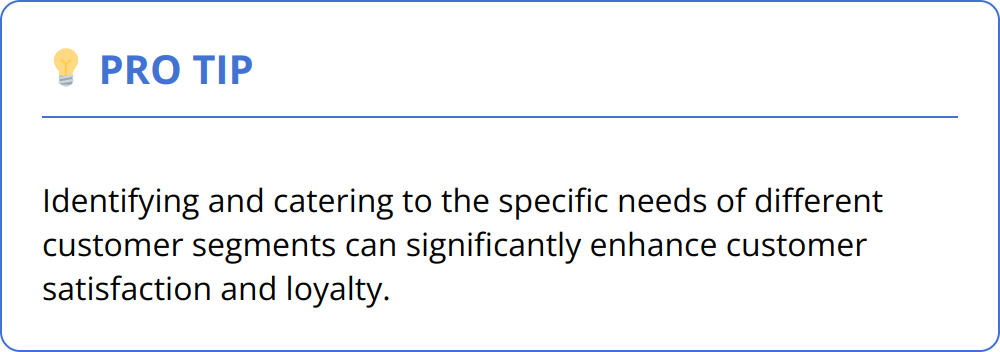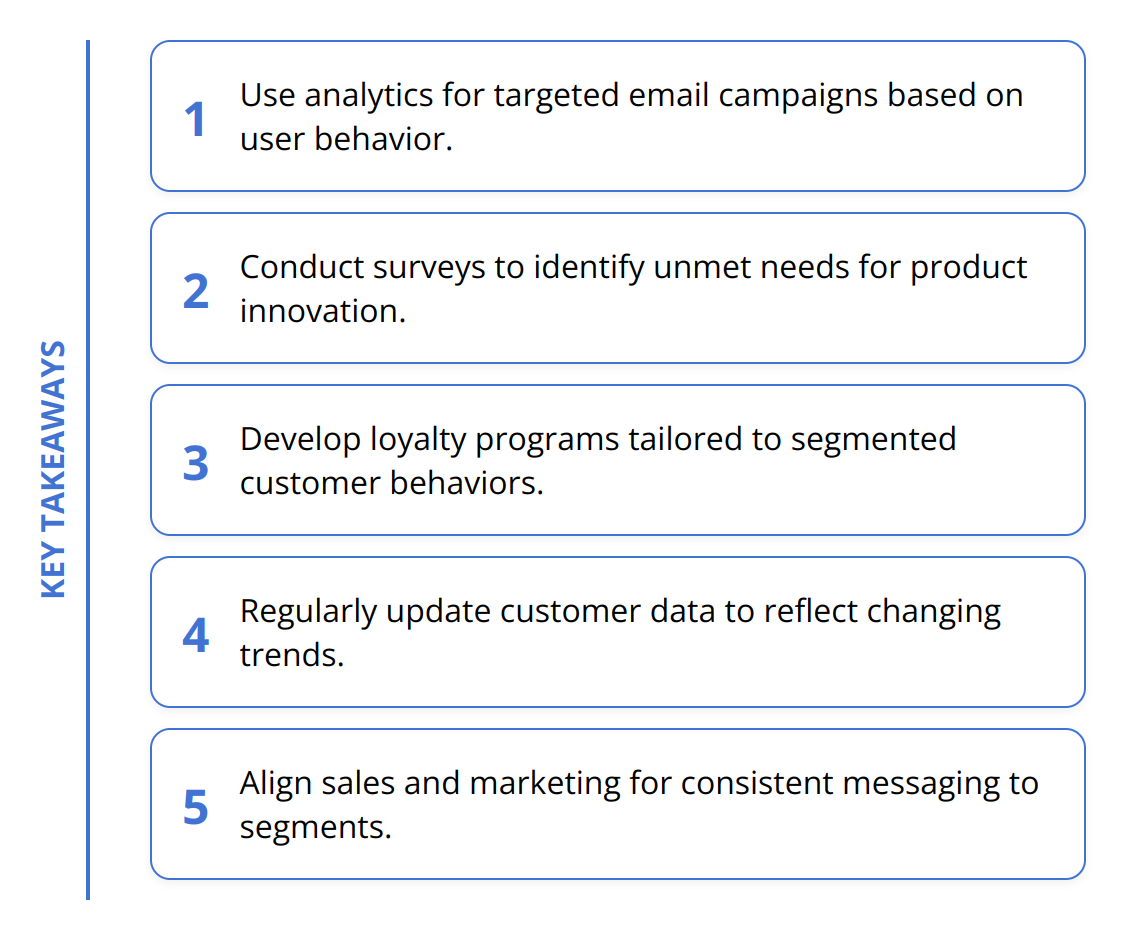Understanding your customers is the foundation of building effective sales strategies. We at Emplibot believe that customer segmentation is a powerful tool that enables businesses to tailor their approaches for different customer groups. This not only enhances marketing efforts but also drives innovation in product development. Let’s explore how breaking down your customer base can significantly impact your sales.
Contents
ToggleWhy Is Customer Segmentation Vital for Sales?
Grasping the core concept of customer segmentation is pivotal for any business looking to boost its sales. It’s a strategy that divides a company’s target market into approachable groups, allowing for more tailored and effective sales tactics. This targeted approach doesn’t just shoot arrows in the dark; it’s about hitting the bullseye by understanding and catering to the specific needs, behaviors, and preferences of different customer segments.
The primary goal of customer segmentation is to provide a laser-focused marketing strategy that leads to enhanced customer satisfaction and loyalty, eventually driving up sales. By identifying specific groups within your customer base, your business can create customized marketing messages, develop products that genuinely meet the needs of these groups, and set accurate pricing strategies.

Drill Down into Customer Segmentation Types
Customer segmentation typically falls into several categories: demographic, geographic, psychographic, behavioral, and needs-based segmentation. Each type offers unique insights into your customer base:
-
Demographic segmentation sorts customers based on age, gender, income, occupation, and education. It’s straightforward and often the starting point for most segmentation strategies.
-
Geographic segmentation divides customers by location, enabling region-specific marketing strategies that cater to local preferences and cultural differences.
-
Psychographic segmentation goes deeper into customers’ lifestyles, values, interests, and attitudes, offering a nuanced understanding of what drives their purchasing decisions.
-
Behavioral segmentation looks at customers’ interactions with your brand, including purchase history, spending habits, brand loyalty, and product usage patterns.
-
Needs-based segmentation zeroes in on the specific needs and problems of customers, which can lead to innovation and customization in product and service offerings to meet these needs.
The Impact of Customer Segmentation on Sales
Truly grasping customer needs through segmentation leads directly to more effective sales strategies. When you understand what motivates your customers, you can tailor your offerings and communication in ways that resonate deeply. This personalized approach doesn’t just increase sales; it builds long-term relationships.
For instance, utilizing behavioral segmentation can reveal that a segment of customers tends to buy more during a particular season. This insight allows businesses to schedule emails, offers, and ads at the right time, significantly increasing the chance of conversion.
Demographic segmentation might show that a substantial portion of your customer base falls within a certain age range, guiding not just the messaging style but also the platforms on which these messages are shared.
Understanding the psychographics of your customers can lead to the development of products that not only meet practical needs but also align with the values and aspirations of your target segments, fostering a deeper brand connection.
Finally, needs-based segmentation can uncover unmet or under-served needs within your market, offering your business the golden opportunity to innovate and fill these gaps before your competitors do.
Implementing these insights doesn’t require complex tools or hefty investments. Simple analytics tools, customer surveys, and social listening can provide the data needed to start segmenting your customers effectively. The key is to start small, measure the impact, and refine your approach based on real-world data.

Taking the time to understand and implement customer segmentation will unequivocally lead to a more focused, efficient, and successful sales strategy. It’s not just about selling more; it’s about selling smarter. For further reading on utilizing data in customer segmentation, consider exploring predictive customer segmentation and its impact on business growth.
Boosting Sales Through Segmentation
Customer segmentation is not just a method; it’s a sales catalyst. By understanding and applying different facets of segmentation, businesses can increase their marketing precision, innovate products that meet actual needs, and enhance customer satisfaction, which in turn skyrockets loyalty and sales.
Enhance Marketing Precision
Segmented marketing allows businesses to communicate with their audience in a more personalized manner. With behavioral and demographic segmentation, companies can send tailored messages that speak directly to the customer’s needs and preferences. A study showed that emails segmented based on user behavior have a 50% higher click-through rate. Instead of broad, generic campaigns, opt for personalized ones targeting specific age groups, locations, or purchasing behaviors.
Practical tip: Use analytics tools to track user behavior on your website and segment your email list accordingly for highly targeted campaigns.

Fuel Product Innovation
Successful products are those that solve a real problem or meet a specific need. With needs-based segmentation, companies can identify gaps in the market and innovate to fill them. This approach not only makes the product development process more efficient but also ensures that new products have a ready market. For example, understanding that a segment of your market prioritizes sustainability can lead to the development of eco-friendly products, tapping into an already interested customer base.
Actionable insight: Conduct survey-based research within different customer segments to uncover unmet needs and prioritize those findings in your product development.
Elevate Customer Satisfaction and Loyalty
Knowing your customers better means you can serve them better. Psychographic segmentation unveils deeper insights into what drives your customers’ behavior, attitudes, and preferences. This intelligence allows for creating experiences, services, and products that resonate on a personal level, significantly enhancing customer satisfaction. High satisfaction leads to increased loyalty, with statistics indicating loyal customers are worth up to 10 times as much as their first purchase over the long haul.
Strategy recommendation: Develop loyalty programs that reward repeat purchase behaviors and preferences identified through segmentation analysis.
By effectively applying customer segmentation, businesses can not only enhance their sales strategies but also build deeper, more meaningful relationships with their customers, leading to sustainable growth. For an in-depth look at leveraging segmentation for loyalty programs, consider reading our piece on automated reward programs.
Remember, the essence of segmentation is about treating your customers as individuals with unique needs and preferences. It’s a powerful strategy that, when executed correctly, can significantly bolster your sales results.
Implementing Customer Segmentation
To ride the wave of customer segmentation success, a business must not only understand its importance but also execute it with precision. This means collecting and analyzing rich customer data, developing segmentation-based sales tactics, and continuously monitoring and fine-tuning these strategies. Here’s how you can put these insights into action, driving your sales numbers up and fostering stronger customer connections.
Gathering Rich Customer Insights
The foundation of any successful segmentation strategy lies in data collection. Utilizing tools like Google Analytics for website behavior, social media analytics for engagement, and CRM software for transactional data can provide a wealth of information. Regular customer feedback through surveys and direct communication channels should not be overlooked. It offers qualitative insights that quantitative data might miss.
Key Actions:
-
Regularly update customer data to capture evolving trends.
-
Use a combination of analytics tools and direct feedback for holistic customer understanding.
-
Prioritize data privacy and consent in all collection methods.
Crafting Segmentation-Based Sales Tactics
Once you have a robust dataset, developing targeted sales tactics becomes your focus. This involves creating customized messaging, timing your communications effectively, and choosing the right channels for each customer segment. For example, a segment identified as being highly active on social media might respond better to campaigns on these platforms rather than traditional email marketing.
Tailor your value proposition to match the unique needs and preferences of each segment. Products or services should be positioned differently based on the segment’s characteristics, emphasizing benefits that align with their specific interests or pain points.
Key Actions:
-
Align sales and marketing efforts for cohesive messaging across segments.
-
Continuously test and refine messaging and channels for optimal engagement.
-
Leverage automation tools for efficient, personalized communication.
Adapting and Evolving Your Strategy
Customer needs and market dynamics change continuously. Regularly assess the performance of your segmentation strategy through metrics like conversion rates, customer lifetime value, and satisfaction scores. Use this data to adapt your approach, potentially identifying new segments or modifying existing ones.
Stay ahead of the curve by keeping an eye on industry trends and competitor strategies. This proactive approach ensures your sales tactics remain relevant and effective.
Key Actions:
-
Set clear KPIs to measure the impact of your segmentation strategy.
-
Schedule periodic reviews of your segmentation approach and adjust as necessary.
-
Foster a culture of innovation and adaptability within your team.

In practice, implementing customer segmentation is an ongoing process that demands attention to detail and a willingness to adapt. With the right data, a strategic approach to sales tactics, and a finger on the pulse of customer evolution, businesses can maximize their sales potential. For those looking to dive deeper into creating effective automated customer surveys, automated customer surveys offer valuable insights into refining segmentation strategies.
The journey to mastering customer segmentation in sales doesn’t end here. As customer behaviors and market conditions evolve, so must your strategies, ensuring your business remains connected and relevant to its most valuable asset: its customers.
Wrapping Up
Throughout this exploration, the significance of customer segmentation for bolstering sales strategies has been highlighted. At its core, segmentation represents a keen understanding of your customer base, allowing for tailored approaches that resonate more personally with each group. This not only elevates sales but also strengthens customer relationships, fostering loyalty and repeat business.

Effective segmentation leads to enhanced marketing precision, where messages hit the mark every time. It fuels product innovation by identifying and addressing the unmet needs of distinct customer groups. Most importantly, it crafts experiences that elevate customer satisfaction and loyalty, laying the groundwork for sustained business growth.
We at Emplibot urge businesses to prioritize customer segmentation in their planning. It’s not merely a tactic but a comprehensive strategy that can transform your approach to sales and marketing. By dividing your audience into meaningful segments, you can deliver more relevant, effective messages and offers. Plus, understanding the nuances of your market segments helps in allocating resources more efficiently, ensuring that your efforts yield the best possible returns.
As you aim to deepen your connection with your target audience, remember, the tools and data needed for impactful segmentation are more accessible than ever. Leveraging this approach will not only set you apart from the competition but also position your business for sustainable success.
For those looking to propel their content strategy alongside customer segmentation, Emplibot offers an invaluable solution. With the ability to publish SEO-friendly articles automatically to your WordPress site, Emplibot ensures your blog remains active, engaging, and relevant, without the heavy lifting. This automation frees up valuable time for you to focus on fine-tuning your sales and marketing strategies, allowing you to reap the full benefits of a well-segmented customer base.
In the constantly evolving landscape of sales and marketing, embracing customer segmentation is more than a strategic advantage—it’s essential. Starting with a solid understanding of your customer segments will enable you to craft messages that resonate, offers that intrigue, and products that delight. Make customer segmentation a cornerstone of your business planning, and watch as your sales strategies flourish, and your customer relationships deepen.










 Rated Excellent 4.5
Rated Excellent 4.5